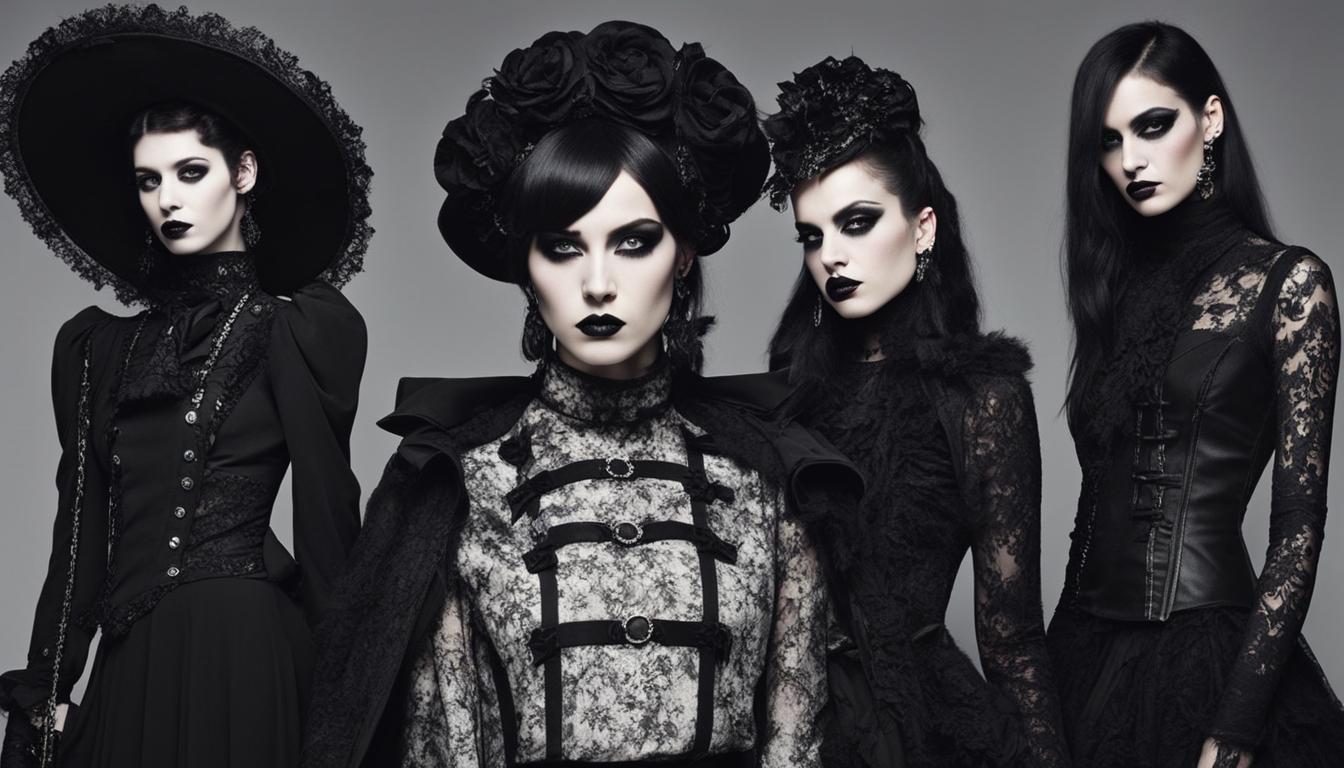Goth culture, a popular trend among many young people, is characterized by a dark attitude and outlook on life. However, it is important to understand that not all goth individuals are depressed or obsessed with death and Satan. Goth culture encompasses diverse interests, religious beliefs, and political affiliations. It is a way for like-minded individuals to come together, appreciate the intricacies of life, and express themselves creatively.
- Goth culture is not solely about depression or obsession with death.
- Goths have diverse interests, beliefs, and affiliations.
- Goth culture provides a sense of belonging and creative expression for individuals.
- The goth community appreciates the intricacies of life.
- Understanding goth culture promotes acceptance and breaks stereotypes.
The Gothic Lifestyle
The goth lifestyle goes beyond just fashion and music, encompassing a unique way of thinking and approaching life. It is often misunderstood by those who are not familiar with the subculture. While many people associate goth culture with darkness and depression, it is important to recognize that not all goths are obsessed with death or have morbid interests.
Goth individuals have diverse beliefs, interests, and lifestyles that may not align with common misconceptions. They may have traditional religious beliefs, family values, and political preferences that reflect their individuality. The goth attitude is often characterized by a desire to belong to a community of like-minded individuals who appreciate the intricacies of life and express themselves creatively. This sense of belonging can bring comfort and acceptance to goths who may feel misunderstood by mainstream society.
The goth community plays a crucial role in supporting goth individuals and fostering a sense of belonging. It provides a safe space for goths to express themselves without fear of judgment or ridicule. Within the goth community, goths can connect with others who share similar beliefs, interests, and aesthetics. This community is not limited to physical spaces but also extends to online platforms and social media groups, allowing goths from all over the world to connect and share their experiences.
Goth Fashion
Goth fashion is a distinct characteristic of the goth subculture, with its unique style and aesthetic. The goth clothing reflects the individuality and expression that goths value in their fashion choices. Black is the predominant color choice among goths, symbolizing their affinity for darkness and mystery. Outfits are often composed of layered black clothing, creating a visually striking and dramatic look.
Goths also use makeup to enhance their gothic appearance, with pale skin, dark eyeliner, and black or dark-colored lipstick being common. These makeup choices contribute to the overall goth aesthetic, emphasizing the intensity and depth of their emotions. Accessories play a significant role in goth fashion, with skull motifs, cross necklaces, and fishnet stockings being popular choices. The right choice of shoes, particularly black boots, is also crucial to complete the goth look.
Gothic Attire: Expressing Individuality
Gothic attire allows individuals to express their unique personalities and embrace their darker side. It provides a sense of empowerment and authenticity, allowing goths to challenge societal norms and embrace their individuality. Goth fashion is not limited to a specific gender or body type; it is inclusive and adaptable to different styles and preferences.
“Goth fashion gives me a sense of liberation and allows me to fully express who I am. I love how it challenges traditional beauty standards and allows me to embrace my darker side.” – Emily, a goth fashion enthusiast
Embracing the Dark Aesthetic
Goth fashion is not just about wearing black; it encompasses a dark aesthetic that speaks to the goth subculture’s fascination with the macabre and the mysterious. Goths find beauty in darkness and seek to communicate their emotions through their fashion choices. The goth fashion scene continues to evolve, incorporating influences from various subcultures and eras to create a unique and ever-changing style.
- Goth fashion embraces individuality and rejects mainstream trends.
- The goth clothing is characterized by layered black outfits.
- Makeup, accessories, and footwear complete the goth aesthetic.
- Goth fashion allows individuals to express their unique personalities.
- It embraces the dark aesthetic and challenges traditional beauty standards.
Goth Music
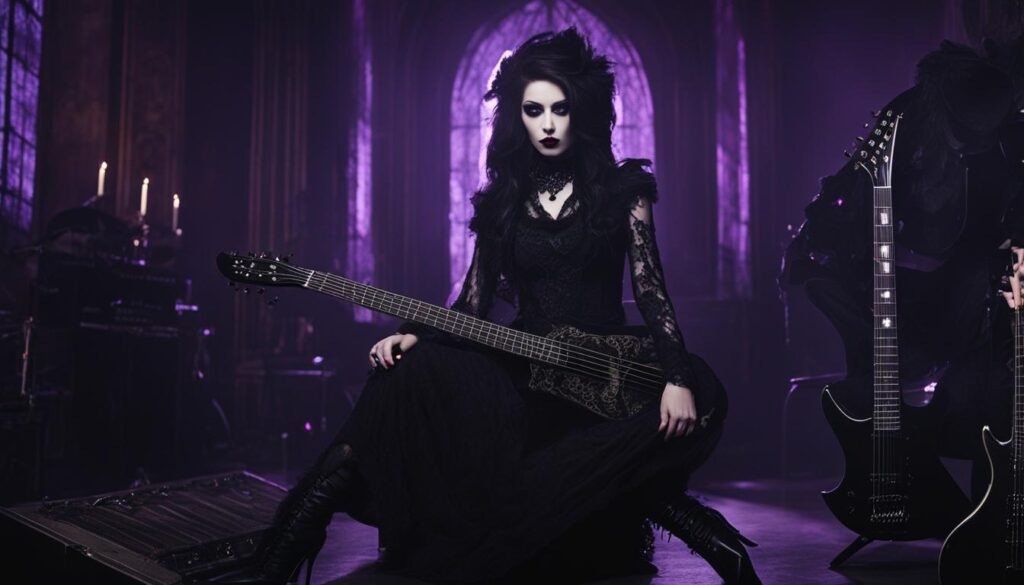
Goth music is an integral part of goth culture, with its unique blend of dark and introspective themes. While gothic rock is the most prominent genre associated with goth culture, goths have diverse musical interests that extend beyond this genre. Punk rock, with its raw energy and rebellious spirit, also holds a significant place in the hearts of many goths. Bands like The Cure, Sisters of Mercy, and Bauhaus have set the foundation for gothic rock, captivating audiences with their haunting melodies and poetic lyrics.
“Goth music offers a cathartic and emotional escape,” says Jane, a devoted goth fan. “The melancholic melodies and introspective lyrics resonate deeply with me, providing solace and understanding during challenging times.”
“Goth music reflects the inner thoughts and experiences of goth individuals,” explains music historian, Dr. Emily Collins. “It delves into emotions often considered taboo in mainstream society, allowing goths to explore and express their true selves.”
Through goth music, goths find solace, inspiration, and a sense of belonging within the subculture. It serves as a powerful medium for expressing their emotions, connecting with others who share similar experiences, and embracing the unique beauty found in the darker side of life.
Goth Symbolism: Exploring the Dark Aesthetics and Imagery
Goth culture is rich in symbolism and imagery, drawing inspiration from various sources such as horror films, vampire culture, and 19th-century Gothic literature. These influences permeate through goth fashion, music, art, and overall aesthetic. The goth subculture embraces the dark side of life, finding beauty and fascination in the macabre.
In goth symbolism, certain motifs and objects hold significant meaning. Skulls, crosses (particularly Celtic versions), and other occult symbols are commonly used to convey a sense of mortality, spirituality, and the mysterious. These symbols are not meant to be taken literally but serve as powerful representations of the gothic mindset and aesthetics.
Furthermore, gothic imagery often includes dark and atmospheric elements, such as graveyards, haunted castles, moonlit landscapes, and eerie creatures. These visuals evoke a sense of mystery, melancholy, and romanticism, encapsulating the essence of goth culture.
Embracing Gothic Literature: A Source of Inspiration
“The world of Gothic literature is a treasure trove of inspiration for goths, offering haunting tales, complex characters, and atmospheric settings. From classic works like Mary Shelley’s ‘Frankenstein’ to Edgar Allan Poe’s dark poetry, goths find solace and inspiration in these literary masterpieces. The themes of isolation, grotesque beauty, and the duality of human nature resonate deeply within the goth community.”
Incorporating elements of gothic literature into various aspects of goth culture allows individuals to express their love for the darker aspects of life and explore the complexities of the human experience.
The use of goth symbolism and imagery serves as a tool for self-expression, allowing goths to connect with their individuality and the goth aesthetic. It is through these visual representations that goth individuals can explore their emotions, challenge societal norms, and find beauty in darkness.
Goth Art
Goth art is a powerful medium of expression within the goth subculture, encompassing various forms such as paintings, sculptures, photography, and digital art. It embraces the dark and macabre, allowing artists to explore themes of horror, fantasy, and the beauty found in darkness. Goth artwork often evokes strong emotions and challenges societal norms, offering a unique perspective on the complexities of the human experience. From hauntingly beautiful landscapes to intricate depictions of gothic imagery, goth art captivates the viewer and invites them into a world of darkness and beauty.
The gothic aesthetic heavily influences goth art, with its emphasis on intricate details, symbolism, and atmospheric elements. Many goth artists draw inspiration from Gothic literature, horror films, and vampire culture, infusing their creations with a sense of mystery and darkness. These artworks not only celebrate the goth subculture but also serve as an invitation for individuals outside the subculture to appreciate and explore the beauty found in darkness.
Gothic Artwork:
- Explores themes of horror, fantasy, and the macabre
- Challenges societal norms and expectations
- Incorporates symbolism and intricate details
- Invokes strong emotions and captures the beauty found in darkness
- Draws inspiration from Gothic literature, horror films, and vampire culture
Goth art not only serves as a means of self-expression for the artists themselves but also allows goth individuals to connect with and appreciate the aesthetic and philosophy of the subculture. It encourages exploration of the darker aspects of life and offers a window into the complexities of human emotion. Through goth art, the beauty found in darkness is celebrated and shared with others, creating a sense of connection and understanding within the goth community and beyond.
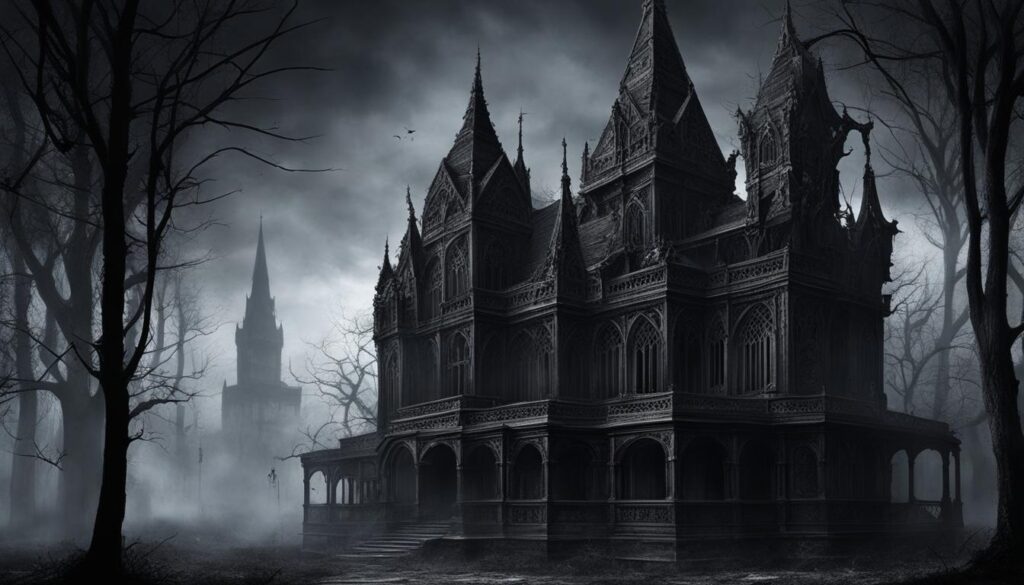
Goth Influences
Goth culture has been shaped by a variety of artistic and cultural influences throughout history. Its evolution can be traced back to the post-punk movement in England during the early 1980s, where bands like Joy Division, Bauhaus, and Siouxsie and the Banshees paved the way for the goth trend. These early gothic rock bands not only influenced the music of the subculture but also contributed to the development of a distinct goth fashion aesthetic.
Aside from music, goth culture has been heavily influenced by various forms of art, literature, and film. Gothic literature, with its dark and mysterious themes, has had a significant impact on the goth subculture. Works by authors such as Edgar Allan Poe, Bram Stoker, and Mary Shelley have inspired goths to explore the macabre and embrace the beauty found in darkness. Horror films, vampire lore, and 19th-century Gothic imagery have also played a role in shaping the goth aesthetic and symbolism.
The goth subculture has proven to be resilient and continues to attract a devoted following, despite the evolution of other subcultures. Its enduring appeal can be attributed to the diverse range of influences it draws from, creating a unique and captivating culture that resonates with individuals seeking a deeper understanding of life’s complexities.
Goth Community: A Supportive Network for Like-minded Individuals
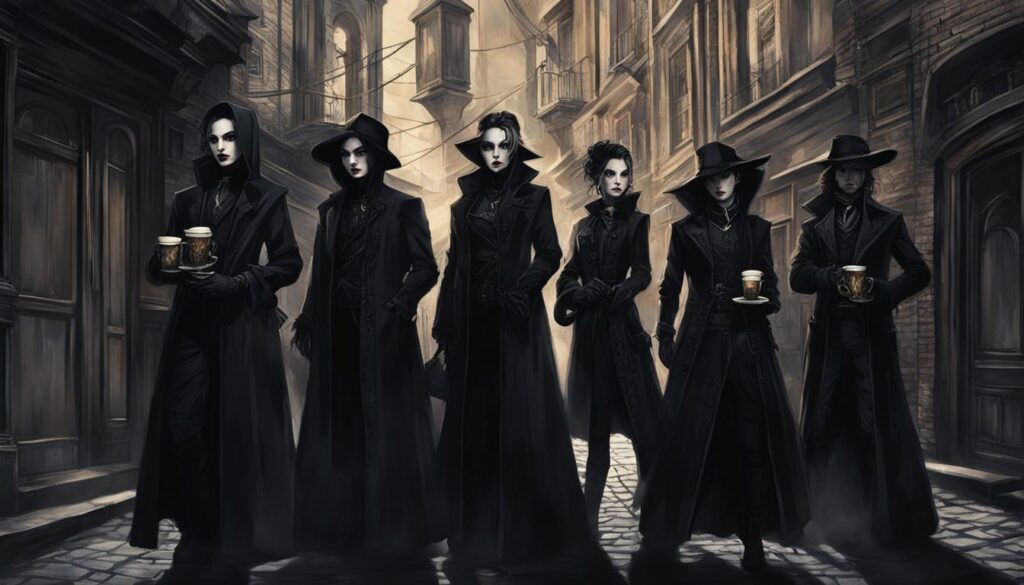
The goth community serves as a sanctuary for individuals who embrace goth culture, providing a supportive network for like-minded individuals to connect and express themselves freely. Within this community, goths find acceptance and understanding, which can be difficult to come by in mainstream society. Whether online or through local events, goth individuals have the opportunity to build strong relationships and form lasting connections with others who share their interests and values.
One of the pillars of the goth community is the sense of support it offers. Goths often face judgment and misconceptions from others who fail to understand their unique perspective. By coming together, goths can find solace in the shared experiences and challenges that come with embracing the goth lifestyle. This support extends beyond socializing and can include mental health resources, guidance on navigating societal expectations, and access to inclusive spaces where they can freely express themselves.
Goth events play a vital role in strengthening the goth community. From concerts and festivals to meet-ups and gatherings, these events offer a platform for goths to celebrate their shared interests and passions. Attending goth events provides a sense of belonging and allows individuals to explore and appreciate various aspects of goth culture alongside others who are equally passionate. These events foster a sense of unity and camaraderie, reinforcing the support network within the goth community.
Gothic Subculture Support: Bridging Connections and Inspiring Creativity
“The goth community has been a source of inspiration and empowerment for me. Through events and online platforms, I’ve connected with incredible individuals who have enriched my life and encouraged my creative pursuits.” – [Anonymous]
The goth community also thrives through online platforms and social media groups, serving as a space for goths to connect with each other globally. These platforms allow individuals to share their experiences, exchange ideas, and promote the goth culture they hold dear. Through online interactions, goths can find advice, support, and friendship, bridging geographical distances and creating a sense of unity among goth individuals worldwide.
In conclusion, the goth community offers a safe haven where goth individuals can connect, support each other, and celebrate their shared interests. Through events, online platforms, and social media groups, goths find acceptance, understanding, and the freedom to express themselves authentically. This vibrant community serves as a source of inspiration and empowerment, fostering creativity and embracing diversity within the goth subculture. By embracing the goth community, individuals can find solace and strength in a network that embraces their unique identity and encourages self-expression.
Goth Stereotypes and Misconceptions
Goth culture is often subject to stereotypes and misconceptions from those who do not understand it. Common misconceptions include the belief that goths are obsessed with death, Satan worshipers, or involved in self-harm. These stereotypes fail to capture the true essence of goth culture, which is a diverse and multifaceted subculture with individuals who have a wide range of beliefs, interests, and lifestyles. It is important to challenge these stereotypes and seek a deeper understanding of goth culture to combat prejudice and promote acceptance.
Goths are often misunderstood as being morbid and depressed, but this is not necessarily the case. While goth individuals do appreciate the aesthetics of darkness and may have a fascination with macabre themes, it does not mean that they are unhappy or mentally unstable. Many goths find solace and beauty in exploring the complexities of life, including the darker aspects, and they express themselves creatively through fashion, music, and art.
Another common misconception is that all goths are involved in occult or Satanic practices. This is a stereotype that has been perpetuated by media portrayals and misunderstandings. In reality, goth culture is not inherently tied to any specific religious or spiritual beliefs. Goths may have diverse religious affiliations, or they may not adhere to any particular belief system at all. Their interest in gothic imagery and symbolism is often rooted in a love for the aesthetic and artistic expression, rather than any association with dark magic or devil worship.
In order to fully appreciate and respect goth culture, it is essential to challenge these misconceptions and stereotypes. By promoting understanding and acceptance, we can create a more inclusive society that values individuality and diversity.
Goth and Emo: Similarities and Differences
Goth and emo are two distinct subcultures that share some similarities but also have their own unique characteristics. While both embrace a dark aesthetic and deal with themes of romance and emotional experiences, goth and emo have different origins and cultural influences.
Goth culture has its roots in gothic music and fashion, emerging in the early 1980s as an offshoot of the post-punk movement in England. Goth individuals are often drawn to the macabre, exploring deep emotions and expressing themselves through dark and intricate fashion choices.
Emo, on the other hand, evolved as a subculture influenced by goth culture but with its own distinct style and emotions. Emo emerged in the 1990s as a genre of music characterized by expressive and confessional lyrics. Emo fashion aligns more with mainstream streetwear style, incorporating geeky t-shirts, v-neck jumpers, and tight skinny jeans.
While goth and emo may share similar emotional themes, their music and fashion differ. Goth music encompasses various styles like gothic rock, industrial, deathrock, neoclassical, ethereal wave, and darkwave, while emo music evolved from hardcore punk and is characterized by its emotionally charged lyrics. Goth fashion tends to be more focused on black clothing and a Victorian or punk aesthetic, while emo fashion incorporates colorful highlights in black hair and a more casual streetwear style.
Similarities:
- Embrace a dark aesthetic and explore themes of romance and emotional experiences
- Both subcultures value self-expression and individuality
- Both have devoted communities and fan bases
Differences:
- Goth culture originated from gothic music and fashion, while emo culture emerged as a subculture influenced by goth culture but with its own style and emotions
- Goth music encompasses various genres like gothic rock, industrial, deathrock, neoclassical, ethereal wave, and darkwave, while emo music evolved from hardcore punk
- Goth fashion tends to be more focused on black clothing, Victorian or punk aesthetic, pale skin, and dark makeup, while emo fashion leans towards streetwear style with colorful highlights in black hair
“Goth and emo may be different subcultures, but both offer individuals a way to express their emotions and find a sense of belonging within a community.” – Quote from a goth enthusiast
Goth Fashion vs Emo Fashion
Goth fashion and emo fashion share some similarities, but they also have key differences that set them apart. Goth fashion is characterized by a dark and dramatic aesthetic, often incorporating Victorian or punk-inspired elements. The predominant color choice in goth fashion is black, with layered clothing and a focus on creating a mysterious and edgy look. Makeup is a crucial component, with goths often opting for pale skin, dark eyeliner, and black or dark-colored lipstick. Accessories such as skull motifs, cross necklaces, and fishnet stockings are also common in goth fashion. Black boots, particularly with platform soles, are a staple footwear choice.
On the other hand, emo fashion takes inspiration from goth culture but has its distinct style. Emo fashion tends to be more casual and leans towards streetwear aesthetics. Emo individuals often prefer to wear geeky t-shirts, v-neck jumpers, and tight skinny jeans. Unlike goth fashion, which primarily focuses on black, emo fashion embraces a wider range of colors, including bright and pastel shades. Hair color is another distinguishing feature, with emo individuals often adding colorful highlights to their black hair, creating a playful and youthful appearance.
While both goth and emo fashion express individuality and a sense of identity, they utilize different aesthetics and color palettes to do so. Goth fashion tends to be more bold, theatrical, and influenced by historical periods, while emo fashion aligns more with mainstream streetwear style, with a touch of alternative “geek chic.” Each subculture’s fashion choices reflect their unique perspectives and artistic influences, allowing individuals to find a style that resonates with their personal aesthetic and interests.
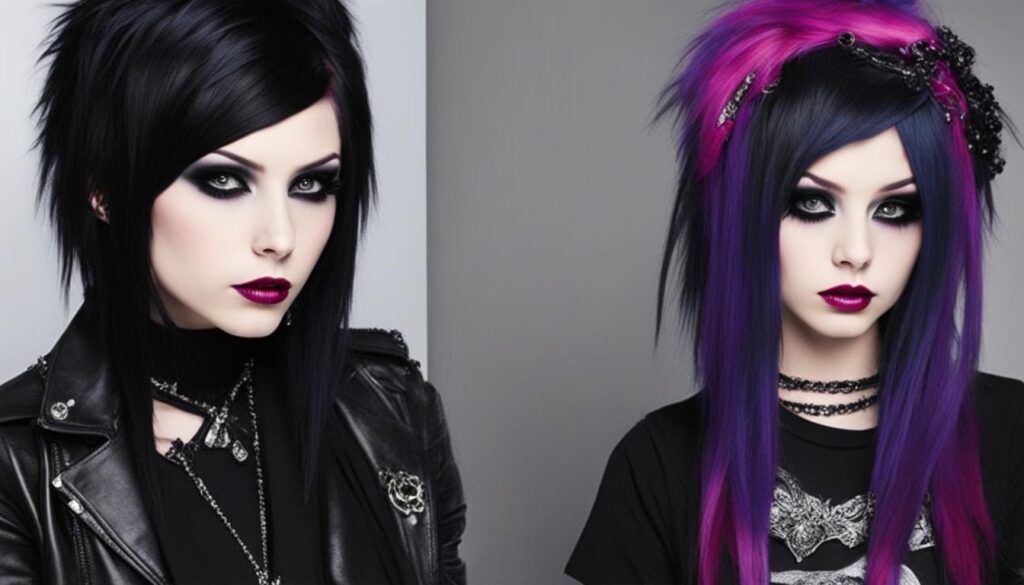
Key Points:
- Goth fashion incorporates a dark and dramatic aesthetic, focusing on black clothing, layered outfits, and accessories like skull motifs and fishnet stockings.
- Emo fashion is more casual and embraces a wider range of colors, often incorporating geeky t-shirts, v-neck jumpers, and tight skinny jeans.
- Goth fashion leans towards historical and punk-inspired elements, while emo fashion aligns with mainstream streetwear style.
- Goth fashion emphasizes a mysterious and edgy look, while emo fashion has a playful and youthful appearance.
- Both goth and emo fashion allow individuals to express their individuality and personal aesthetic.
Goth Music vs Emo Music
Goth music and emo music are two distinct genres that have emerged from different subcultures, each with its own unique style and themes. While both genres explore emotional experiences, they differ in terms of musical genre, lyrical content, and cultural influences.
Goth music encompasses a variety of styles including gothic rock, industrial, deathrock, neoclassical, ethereal wave, and darkwave. The music often features introspective and atmospheric sounds that create a dark and ethereal ambiance. Goth music expresses the complexities of life, delving into intense emotions and existential questions.
Emo music, on the other hand, originated from hardcore punk and is characterized by expressive lyrics, a confessional tone, and a strong emphasis on emotions. It often explores themes of heartbreak, personal struggles, and self-reflection. Emo music is known for its raw and emotive sound, connecting deeply with listeners.
The key differences between goth music and emo music include:
- Musical Genre: Goth music encompasses a broader range of styles, while emo music is rooted in the punk genre.
- Lyrical Content: Goth music explores existential and introspective themes, while emo music focuses more on personal experiences and emotional turmoil.
- Cultural Influences: Goth music draws inspiration from Gothic literature, horror films, and vampire lore, whereas emo music emerged as a reaction to emotional experiences within the punk scene.
Both goth music and emo music resonate with their respective subcultures, offering a form of emotional expression and a sense of belonging. It’s important to recognize and appreciate the distinct characteristics of each genre, as they represent different cultural movements and artistic expressions within music.
Goth Stereotypes and Emo Stereotypes
Goth culture and emo culture are often subject to stereotypes and misconceptions that do not accurately represent the complexities of these subcultures. These stereotypes can perpetuate misunderstandings and hinder acceptance and understanding. It is important to challenge these stereotypes and seek a deeper understanding of goth and emo culture.
Goth Stereotypes
Goth stereotypes often portray goths as individuals who are obsessed with death, Satan worshipers, or involved in self-harm. These stereotypes fail to capture the true essence of goth culture, which is a diverse and multifaceted subculture. Goth individuals have a wide range of beliefs, interests, and lifestyles. It is crucial to recognize that goth culture is not solely defined by these misconceptions and instead appreciate the unique perspectives and individuality within the goth community.
Emo Stereotypes
Similarly, emo culture has faced its own set of stereotypes and misconceptions. Emo stereotypes often associate the subculture with self-harm and suicide. These misconceptions arise from media bias and misrepresentation, overlooking the complexity and diversity within the emo community. It is important to understand that emo culture is more than just a fashion trend or a reflection of mental health issues. Emo individuals have their own unique interests, experiences, and ways of expressing themselves.
By challenging these stereotypes and misconceptions, we can foster a more inclusive and accepting society. It is crucial to appreciate the individuality and diversity within goth and emo subcultures, recognizing the value they bring to the cultural landscape. Embracing acceptance and understanding allows us to learn from one another and promotes a more diverse and interconnected world.
Goth as a Way of Life
Goth culture is more than just a passing phase or a fashion trend—it is a way of life for many individuals who resonate with its aesthetics, philosophy, and sense of community. Embracing goth culture means embracing a unique perspective on life and finding solace in expressing oneself creatively. It offers a platform for individuality and self-expression, where individuals can explore the darker aspects of life without fear of judgment or ridicule.
For those who embrace goth as a way of life, it goes beyond just fashion and music. It is a mindset that appreciates the beauty found in darkness, the mysteries of existence, and the allure of the macabre. Goths understand that life is complex and multifaceted, and they choose to confront and explore the full spectrum of human experience.
Embracing goth culture means finding a sense of belonging and acceptance within the goth community. Goths often face rejection and judgment from mainstream society, but within the goth community, they can connect with like-minded individuals who understand and appreciate their unique interests and perspectives. This sense of community provides a support system that is invaluable to those who identify with goth as a way of life.
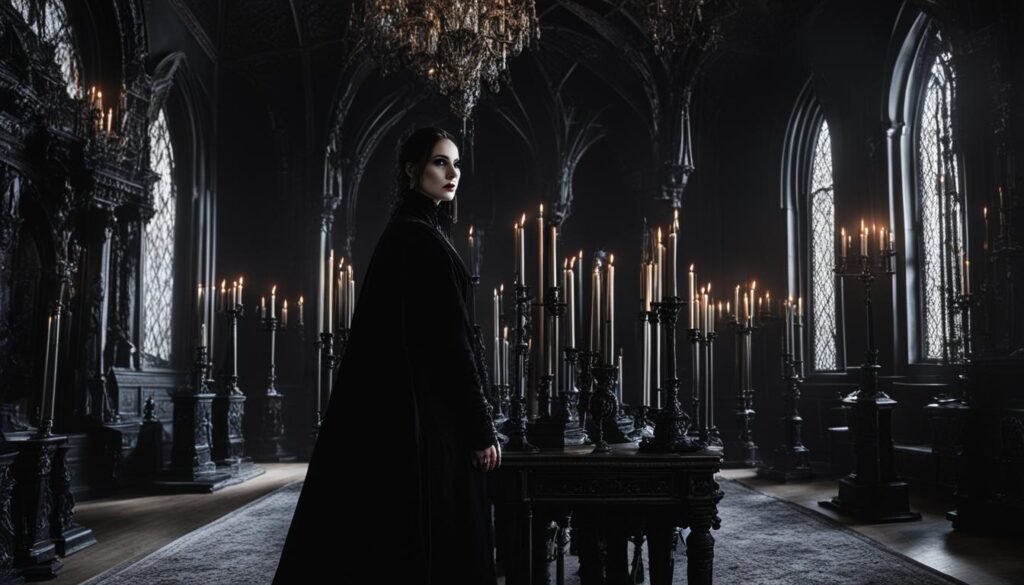
Embracing Individuality and Acceptance
One of the core values of goth culture is the promotion of individuality and acceptance. Goths are encouraged to embrace their unique interests, beliefs, and aesthetics, challenging societal norms and offering a different perspective on the world. By doing so, goths not only enrich their own lives but also contribute to a more inclusive and accepting society as a whole.
When individuals choose to embrace goth culture as a way of life, they are making a statement about their desire to express themselves authentically and without compromise. It is a rejection of conformity and a celebration of the beauty that can be found in the unconventional. By embracing goth culture, individuals are not only embracing their true selves but also opening the door to a world of self-discovery and personal growth.
“Embracing goth culture means finding a sense of belonging and acceptance within the goth community.”
Embracing Goth Culture
Embracing goth culture is a personal choice that allows individuals to explore their emotions, express their creativity, and find acceptance in a community that understands and appreciates their unique perspective. It offers a way of life that values individuality, self-expression, and the beauty found in darkness. By embracing goth culture, individuals can find a sense of belonging and a platform to express themselves authentically.
Appreciating the Beauty in Darkness
The goth culture is an embodiment of the beauty found in darkness. It is a celebration of the unconventional and an exploration of the complexities of life. Goths have a unique aesthetic, an appreciation for the macabre, and a philosophy that challenges societal norms. Through their fashion, music, art, and overall outlook on life, goths embrace the full spectrum of human experience.
The goth aesthetic is characterized by its dark and mysterious allure. From the layered black clothing to the hauntingly beautiful makeup, goths use their appearance as a form of artistic expression. They create a visual representation of their inner thoughts and emotions, embodying the beauty that can be found in darkness.
The goth philosophy encourages individuals to delve into the depths of their emotions and explore the mysteries of existence. It is through this introspection and contemplation that goths find inspiration for their creative endeavors. By embracing the darker aspects of life, goths challenge societal norms and offer a unique perspective on the world.
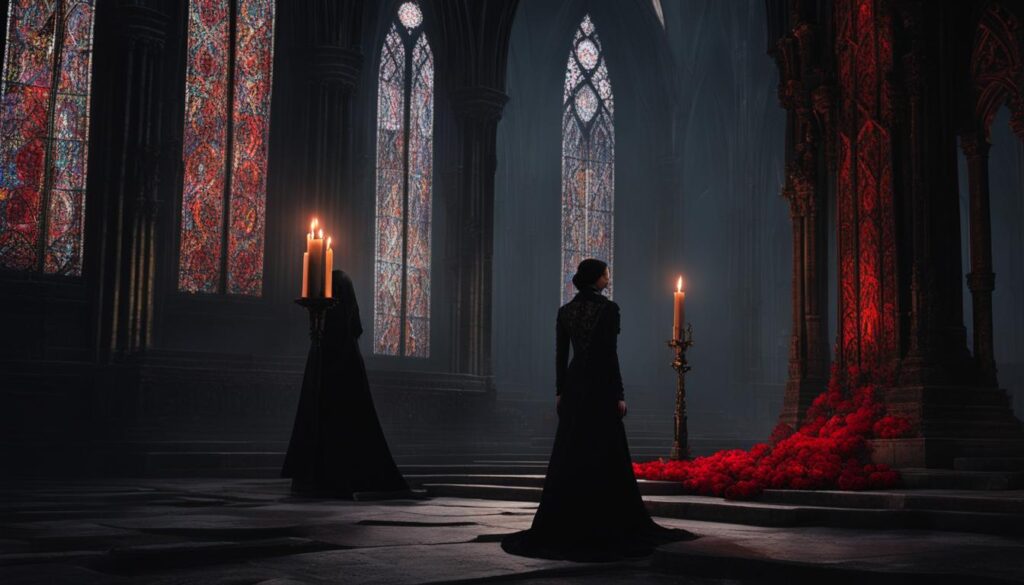
Embracing Individuality and Acceptance
Goth culture is all about embracing individuality and celebrating diversity. It encourages people to express themselves authentically and embrace their unique interests, beliefs, and aesthetics. Goth subculture provides a safe space for individuals to be themselves without fear of judgment or ridicule from society.
By promoting acceptance of goth culture, we are fostering a more inclusive society that values and respects the diversity of its members. It is essential to challenge stereotypes and misconceptions surrounding goth culture, as they fail to capture the true essence of this multifaceted subculture.
Embracing individuality not only benefits goths but also enriches our overall cultural landscape. The goth community thrives on creativity, pushing boundaries, and challenging societal norms. By embracing goth culture, we embrace the beauty of uniqueness and promote a world that celebrates diversity.
Let’s celebrate the goth subculture for what it truly is – a vibrant and diverse community that encourages individuals to be their authentic selves. By promoting acceptance and embracing individuality, we can create a society where everyone feels valued, accepted, and respected.
FAQ
What is goth culture?
Goth culture is a popular trend among many young people, characterized by a dark attitude and outlook on life.
Are all goth individuals depressed or obsessed with death and Satan?
No, not all goth individuals are depressed or obsessed with death and Satan. Many goths have diverse interests, religious beliefs, and political affiliations.
What does goth fashion typically look like?
Goth fashion is characterized by black clothing, layered outfits, dark makeup, and accessories like skull motifs and cross necklaces.
What genres of music are popular within the goth subculture?
The most popular genre among goths is punk rock, but goths also have diverse musical interests ranging from Frank Sinatra to Rob Zombie.
What influences are reflected in goth art?
Goth art draws inspiration from various sources, including horror films, vampire culture, and 19th-century Gothic literature.
When did goth culture originate?
Goth culture originated in the early 1980s as a subculture influenced by post-punk music and bands like Joy Division, Bauhaus, and Siouxsie and the Banshees.
How does the goth community support its members?
The goth community provides a sense of belonging and support for goth individuals who often face rejection and judgment from mainstream society.
What are some common misconceptions about goth culture?
Common misconceptions include the belief that goths are obsessed with death, Satan worshipers, or involved in self-harm, which do not accurately represent the diversity within goth culture.
What is the difference between goth and emo culture?
Goth and emo culture share some similarities in their dark aesthetic and emotional themes, but they have distinct subcultures with their own characteristics and influences.
How is goth fashion different from emo fashion?
Goth fashion tends to focus on black clothing, a Victorian or punk aesthetic, and pale skin, while emo fashion incorporates geeky t-shirts, v-neck jumpers, and tight skinny jeans with colorful highlights.
What sets goth music apart from emo music?
Goth music encompasses various styles like gothic rock, industrial, and darkwave, with a focus on introspective and atmospheric sounds, whereas emo music evolved from hardcore punk and emphasizes expressive lyrics and emotions.
What are some stereotypes and misconceptions about goth and emo cultures?
Stereotypes surrounding goth culture often portray goths as obsessed with death, while emo culture has faced misconceptions associating it with self-harm and suicide.
Is goth culture just a passing trend or a way of life?
For many goths, goth culture is not just a passing phase or fashion trend but a way of life that provides a sense of belonging, self-expression, and acceptance.
What does goth culture appreciate?
Goth culture celebrates the beauty found in darkness, the exploration of emotions, and the allure of the macabre, embracing the full spectrum of human experience.
How does goth culture promote individuality and acceptance?
Goth culture encourages individuals to embrace their unique interests, beliefs, and aesthetics, promoting diversity and challenging societal norms to foster a more inclusive and accepting society.
